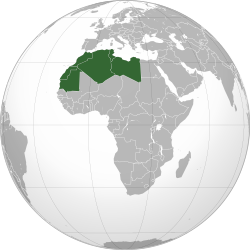| Maghreb المغرب | |
|---|---|
 | |
| Countries and territories | |
| Major regional organizations | African Union, Arab League, Arab Maghreb Union, Common Market for Eastern and Southern Africa, Community of Sahel–Saharan States, Union for the Mediterranean |
| Population | 105,095,436 (2021*)[3] |
| Population density | 16.72/km2 |
| Area | 6,045,741 km2 (2,334,274 sq mi) |
| GDP PPP | $1.299 trillion (2020) |
| GDP PPP per capita | $12,628 (2020) |
| GDP nominal | $382.780 billion (2020) |
| GDP nominal per capita | $3,720 (2020) |
| Languages | |
| Religion | Sunni Islam, Christianity, and Judaism |
The Maghreb (/ˈmɑːɡrəb/;[4] Arabic: ْاَلْمَغْرِب, romanized: al-Maghrib, lit. 'the west' [ælˈmaɣrɪb] ), also known as the Arab Maghreb (Arabic: اَلْمَغْرِبُ الْعَرَبِيُّ, romanized: al-Maghrib al-ʿArabi, lit. 'the Arab west') and Northwest Africa,[5] is the western part of the Arab world. The region comprises western and central North Africa, including Algeria, Libya, Mauritania, Morocco, and Tunisia. The Maghreb also includes the disputed territory of Western Sahara.[note 1] As of 2018, the region had a population of over 100 million people.
The Maghreb is usually defined as encompassing much of the northern part of Africa, including a large portion of the Sahara Desert, but excluding Egypt and the Sudan, which are considered to be located in the Mashriq — the eastern part of the Arab world. The traditional definition of the Maghreb — which restricted its scope to the Atlas Mountains and the coastal plains of Morocco, Algeria, Tunisia and Libya — was expanded in modern times to include Mauritania and the disputed territory of Western Sahara. During the era of al-Andalus on the Iberian Peninsula (711–1492), the Maghreb's inhabitants — the Muslim Maghrebis — were known by Europeans as the "Moors".[6] The Greeks referred to the region as the "Land of the Atlas", referring to its Atlas Mountains.[7]
Before the establishment of modern nation states in the region during the 20th century, the Maghreb most commonly referred to a smaller area, between the Mediterranean Sea and the Atlas Mountains in the south. It often also included the territory of eastern Libya, but not modern Mauritania. As recently as the late 19th century, the term "Maghreb" was used to refer to the western Mediterranean region of coastal North Africa in general, and to Algeria, Morocco, and Tunisia in particular.[8]
During the rule of the Berber kingdom of Numidia, the region was somewhat unified as an independent political entity. This period was followed by one of the Roman Empire's rule or influence. The Germanic Vandals invaded after that, followed by the equally brief re-establishment of a weak Roman rule by the Byzantine Empire. The Islamic caliphates came to power under the Umayyad Caliphate, the Abbasid Caliphate and the Fatimid Caliphate. The most enduring rule was that of the local Arab empires of the Aghlabids, Idrisids, Salihids, Sulaymanids, Umayyads of Cordoba, Hammudids, Nasrids, Saadians, Alawites and the Sennusids, as well as the Berber empires of the Ifranids, Almoravids, Almohads, Hammadids, Zirids, Marinids, Zayyanids, Hafsids and Wattasids, extending from the 8th to 13th centuries. The Ottoman Empire also controlled parts of the region for a period.
Centuries of Arab migration to the Maghreb since the 7th century shifted the demographic scope of the Maghreb in favor of the Arabs. In the 19th and early 20th centuries, the region was ruled by European powers: France (Algeria, Tunisia, Mauritania and most of Morocco), Spain (northern Morocco and Western Sahara), and Italy (Libya). Italy was expelled from North Africa by the Allies in World War II. Decolonization of the region continued in the decades thereafter, with violent conflicts such as the Algerian War, the Ifni War and the Western Sahara War.
Algeria, Libya, Mauritania, Morocco, and Tunisia established the Arab Maghreb Union in 1989 to promote cooperation and economic integration in a common market. The union implicitly included Western Sahara under Morocco's membership.[9] However, this progress was short-lived, and the union is now largely dormant. Tensions between Algeria and Morocco over Western Sahara re-emerged, reinforced by the unresolved border dispute between the two countries. These two conflicts have hindered progress on the union's joint goals.[10]
- ^ BBC News: Western Sahara profile
- ^ City Population: Western Sahara (disputed territory)
- ^ "COUNTRY COMPARISON :: POPULATION". The World Factbook. Central Intelligence Agency. Archived from the original on 27 September 2011. Retrieved 6 August 2018.
- ^ "Definition of MAGHREB". www.merriam-webster.com. Retrieved 17 March 2024.
- ^ English for Students: Northwest Africa Archived 21 July 2018 at the Wayback Machine english-for-students.com
- ^ "The Moors were simply Maghrebis, inhabitants of the Maghreb, the western part of the Islamic world, that extends from Spain to Tunisia, and represents a homogeneous cultural entity", Titus Burckhardt, Moorish Culture in Spain. Suhail Academy. 1997, p.7
- ^ Amin, Samir (1970). The Maghreb in the modern world: Algeria, Tunisia, Morocco. Penguin. p. 10. ISBN 9780140410297. Archived from the original on 30 July 2023. Retrieved 27 August 2017.
- ^ Elisée Reclus, Africa, edited by A. H. Keane, B. A., Vol. II, North-West Africa, Appleton and company, 1880, New York, p.95
- ^ "L'Union du Maghreb arabe". Archived from the original on 20 April 2010. Retrieved 17 May 2010.
- ^ "Maghreb". The Columbia Encyclopedia, Sixth Edition. 2001–05. Archived from the original on 29 September 2007. Retrieved 11 July 2007.
Cite error: There are <ref group=note> tags on this page, but the references will not show without a {{reflist|group=note}} template (see the help page).